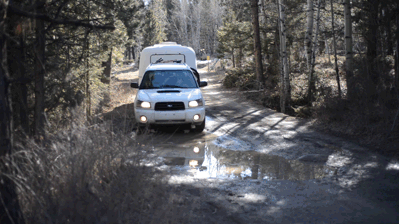Gnarly Roads
Vehicle and camper choice determine which areas are accessible. The warm winter temperatures of southern Arizona attract thousands of nomads and snow birds. The easily accessible, flat camping areas are packed full of giant RVs. These big rigs are often limited in where they can park. To escape these claustrophobic RV neighborhoods, we intentionally look for areas with gnarly roads and small sites. This is where the size and capability of our tiny rig come in handy.
Detachability
Detachability is something we couldn’t see ourselves living without. It is liberating to be able to set up the Scamp, detach and go into town with the Subie. We would be limited if we had to pack up the Scamp to go to town.
The detachable setup also holds our camping spot. If we had a van, and went to town for groceries or wifi, it’s likely that our camping spot would be taken by the time we got back. If we did have a van, we would really have to hone in our systems so that we could pack up and move quickly without our things falling out of their places. This is the primary negative to van life in my opinion. It sucks to pack up the house to go explore. To offset this, I would near definitely have a motorcycle or park close enough to necessary amenities to walk or bike.
If we were van / truck camping, where the vehicle is also the house, I would plan to boondock for at least 2 weeks at a time. This would require a bigger water tank, maybe a refrigerator / diet adjustment, unlimited cell data, and possibly a composting toilet.
In my mind, the ability to live without hookups (power and water) is a definite necessity. I think having to be in an RV park full time would be borderline miserable, and very expensive.
Establish Needs
We try to have a coffee shop or library with good wifi within 30 or so miles of the spots we choose. We require wifi for Elsa to upload at least twice a week. We also like to have a grocery store with preferably organic produce nearby. We generally go to the store twice a week. We eat a lot of veggies and we just have a Yeti cooler to keep our food cool.
The primary things we look for in a town are: a few good places for wifi, a good grocery store, and plenty of BLM or National forest land in the surrounding area. Many places in the western US fit this criteria.
Free Camping
We generally lean on freecampsites.net and the like to do our initial research. Once we find town that meets our criteria, we begin looking for areas with good reviews on the camping websites. Then we figure out where the National Forest / BLM zones are, and pop into Google Maps to find potentially less travelled areas.
We like camping next to interesting geographical features; hills, mountains, lakes, cliffs or streams. This way we don’t have to drive to explore cool places, we can just walk outside and go for a ride or climb.
Choosing a Route
Our mentality is to maximize the journey. We will often look for areas or cites that we can spend a month in. This flies in the face of the common van life narrative, where the idea is to constantly be moving and see all the parks and things. We know that over time we’ll see all the things, but we have to move slowly to afford to continue.
Pulling the Scamp around is quite expensive. This is why we look for towns with enough camping around for us to spend 2 weeks in one spot, then go to the other side of town and spend 2 weeks in another. This saves us lots of money in gas, therefor maximizing the overall journey. This mentality also allows us to spend real time in each place. We get to intimately know the culture, people and nuances of areas we visit.
When we travel, we look for adjacent areas that follow the general trajectory of our route. We try not to zig zag or back track too much.
When we left Kansas City this winter, our overall idea was to get to warmer temperatures. These warm temps were in southern Arizona. When we blasted off, we didn’t really know where we would be staying. I drive and Elsa is copilot and camping researcher. As we drive, we will map out camp sites along the way. We stopped in Texas and New Mexico on the way to AZ.
Once we arrived in AZ, we travelled in a 4 hour radius to the different cities we’ve visited. We started in Sedona, then went to Quartzite, then Lake Havasu, now we’re back in Sedona staging to head north to Colorado.
We will slowly trend north, staying in Flagstaff, Zion, and wherever else for however long makes sense along the way. The idea is to maximize the journey, not tick off all the cites in x number of months.
Optimization
The longer we travel, the more self reliant we become. When we first started traveling, we went to town near daily for showers, power and wifi. Now we can handle these things ourselves, allowing us to stay in nature for longer periods of time. We’ve honed our diet to utilize food that lasts, we have a sufficient solar power system, we use our Yeti as a swamp cooler to keep things cool without ice, and we can cook infinitely with the wood we find on our Biolite.
With this gradual optimization, we can camp further from towns. Now we only need to go to town once or twice a week. This allows us to stay in more remote areas and find the solitude we seek.


